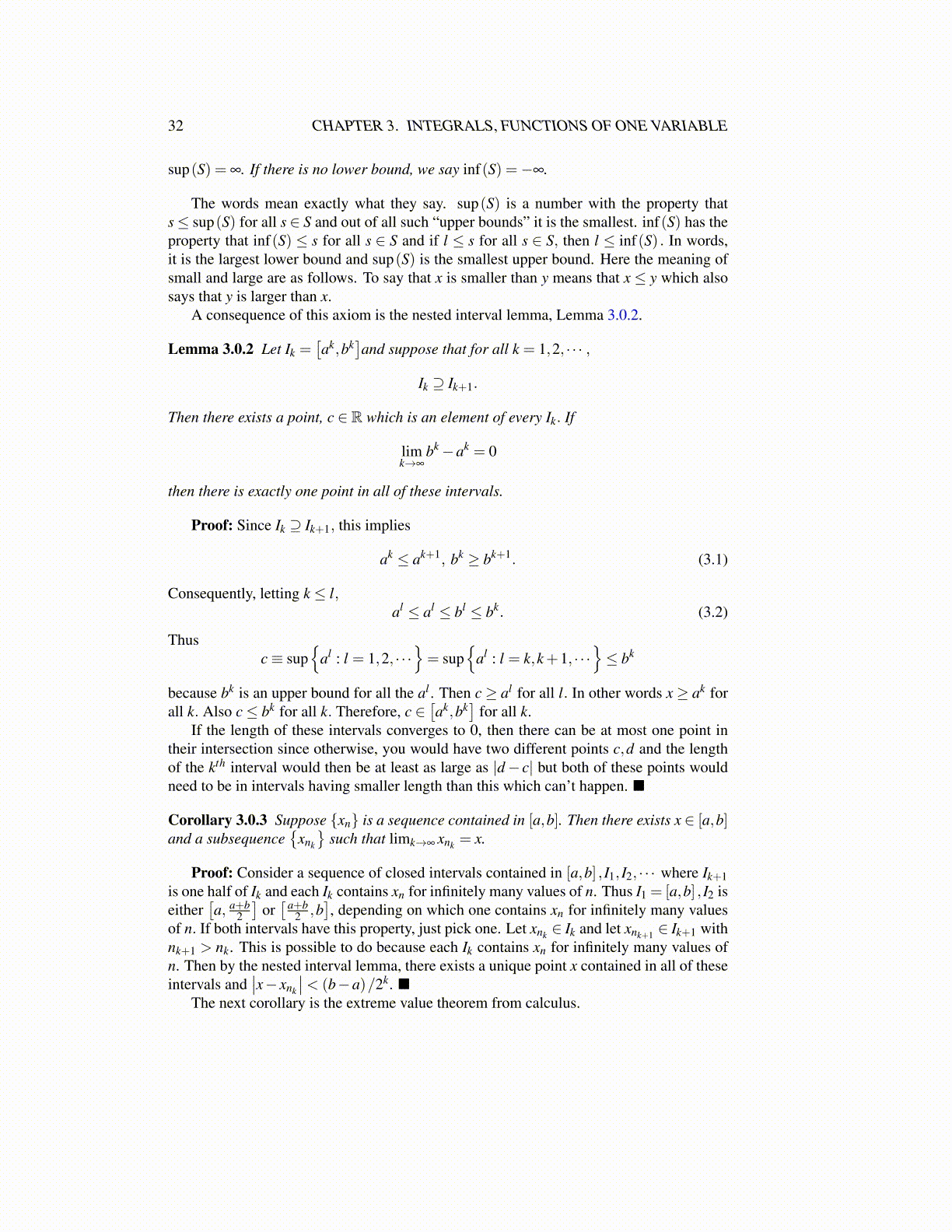
32 CHAPTER 3. INTEGRALS, FUNCTIONS OF ONE VARIABLE
sup(S) = ∞. If there is no lower bound, we say inf(S) =−∞.
The words mean exactly what they say. sup(S) is a number with the property thats≤ sup(S) for all s ∈ S and out of all such “upper bounds” it is the smallest. inf(S) has theproperty that inf(S) ≤ s for all s ∈ S and if l ≤ s for all s ∈ S, then l ≤ inf(S) . In words,it is the largest lower bound and sup(S) is the smallest upper bound. Here the meaning ofsmall and large are as follows. To say that x is smaller than y means that x ≤ y which alsosays that y is larger than x.
A consequence of this axiom is the nested interval lemma, Lemma 3.0.2.
Lemma 3.0.2 Let Ik =[ak,bk
]and suppose that for all k = 1,2, · · · ,
Ik ⊇ Ik+1.
Then there exists a point, c ∈ R which is an element of every Ik. If
limk→∞
bk−ak = 0
then there is exactly one point in all of these intervals.
Proof: Since Ik ⊇ Ik+1, this implies
ak ≤ ak+1, bk ≥ bk+1. (3.1)
Consequently, letting k ≤ l,al ≤ al ≤ bl ≤ bk. (3.2)
Thusc≡ sup
{al : l = 1,2, · · ·
}= sup
{al : l = k,k+1, · · ·
}≤ bk
because bk is an upper bound for all the al . Then c≥ al for all l. In other words x≥ ak forall k. Also c≤ bk for all k. Therefore, c ∈
[ak,bk
]for all k.
If the length of these intervals converges to 0, then there can be at most one point intheir intersection since otherwise, you would have two different points c,d and the lengthof the kth interval would then be at least as large as |d− c| but both of these points wouldneed to be in intervals having smaller length than this which can’t happen. ■
Corollary 3.0.3 Suppose {xn} is a sequence contained in [a,b]. Then there exists x ∈ [a,b]and a subsequence
{xnk
}such that limk→∞ xnk = x.
Proof: Consider a sequence of closed intervals contained in [a,b] , I1, I2, · · · where Ik+1is one half of Ik and each Ik contains xn for infinitely many values of n. Thus I1 = [a,b] , I2 iseither
[a, a+b
2
]or[ a+b
2 ,b], depending on which one contains xn for infinitely many values
of n. If both intervals have this property, just pick one. Let xnk ∈ Ik and let xnk+1 ∈ Ik+1 withnk+1 > nk. This is possible to do because each Ik contains xn for infinitely many values ofn. Then by the nested interval lemma, there exists a unique point x contained in all of theseintervals and
∣∣x− xnk
∣∣< (b−a)/2k. ■The next corollary is the extreme value theorem from calculus.